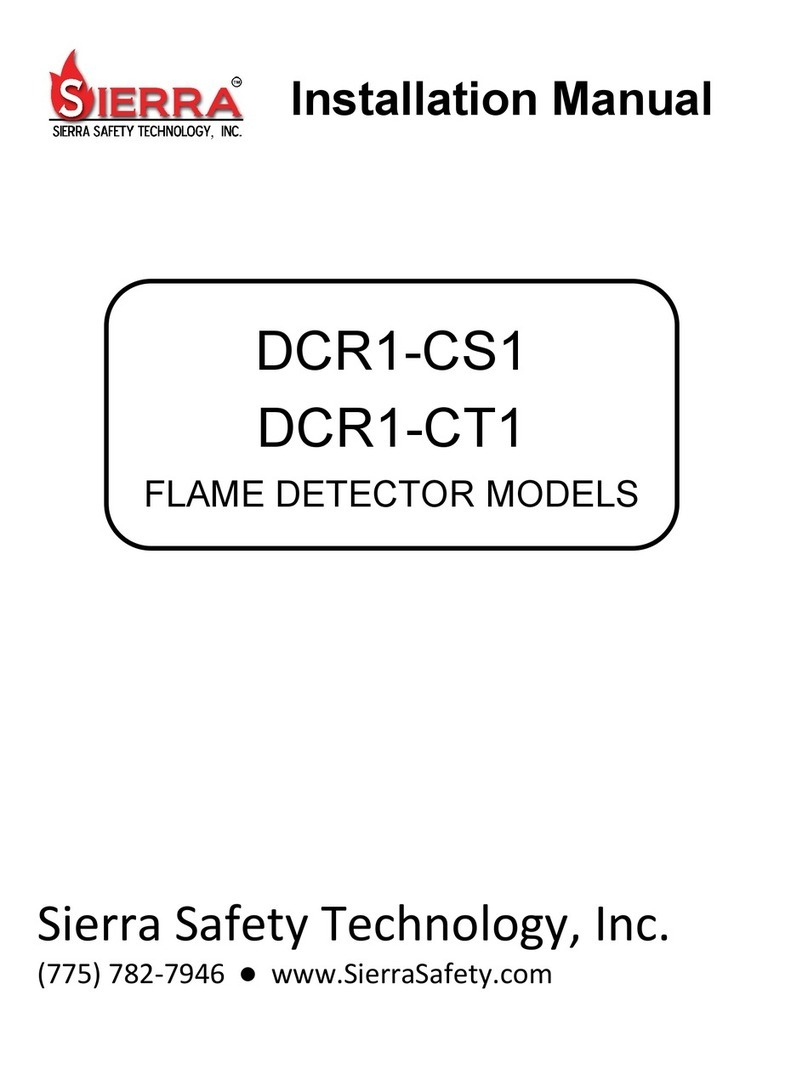
Sierra Safety Technology, Inc.
www.sierrasafety.com
All rights reserved - © 2016
Page 2 of 20
All modes of operation are indicated by two LEDs located on the front of
the detector. Normal Mode is indicated by a brief flash of the LEDs
every 8 seconds. In Normal Mode the detector is constantly monitoring
the environment for a fire.
When a fire is detected the RED1 goes into Alarm Mode. If the device is
configured for “Latching” the device will remain in Alarm Mode until
power is removed. If configured for “Non-Latching” the Fire Relay will
reset to normal when the detector cannot determine there is a fire.
The self-test system is continuously monitoring the internal systems. If
the RED1 is not reporting a fire, then when a fault is detected the
detector goes into Fault Mode. In Fault Mode the LEDs will flash a code
indicating the type of fault. A fault indication may mean the device is
unable to detect a fire or that a device has become unreliable. (i.e. a
“Voltage Low” fault) For most faults the detector will return to Normal
Mode when the fault condition is corrected.
2.2 Field-of-View
Optical Flame Detectors must be able to “see” the fire to declare an
alarm. Any obstruction between the detector and the threat area will
impair the detector’s ability to cover the threat area. An obstruction is
anything that is not transparent to the energy being detected by the
sensor elements of the detector. Even objects such as scaffolds and
ladders within the field of view will impact the detector's response.
Ultraviolet and Infrared sensors cannot see through most types of glass
or plastic even if the glass or plastic is visually transparent. For
coverage of a large area the detectors should be located with
overlapping fields of view (see Figure 6). Flame detectors should never
be located so that they are looking down from a ceiling of large enclosed
spaces as products of combustion may stratify in the enclosed volume.
Such stratification may reduce the detector's speed of response.
2.3 Range
The size of fire and type of materials that constitute the threat will affect
the detector’s range. Different materials and environmental conditions
produce different amounts of the radiant energy from the fire that is used
by the detector to “see” the fire. Also, the range of the detector is a
function of the fire size. The RED1 Detector is optimized to detect a 1
sq. ft. gasoline fire on axis within 80 feet when the sensitivity settings set
to maximum.
The RED1 can be set for lower sensitivity using the dipswitches located
on the face of the module.
2.4 Environment
All optical flame detectors sense radiant energy at some frequency or
frequencies within their Field-of-View. Any source that radiates energy
at the same frequency or frequencies used by the detector to sense a
fire may impact the detector’s ability to “see” the fire (see Table Error!
Reference source not found.). Care should be taken to minimize




























